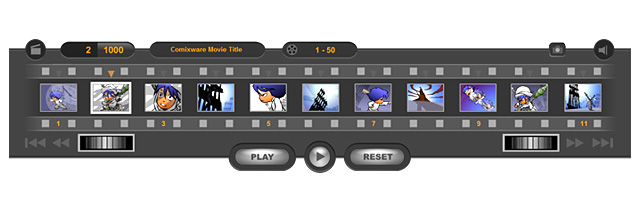Timeline
Strip

General
The
filmstrip like Timeline that you see across Compose, Play, Save, and
Gallery sections is the central metaphor of Comixware interface. It links the four
major functions of this Program (composing, screening, archiving, and communication) in one unified
visual representation. That is: you build and compose your movie in the Timeline
(Compose section); you preview and showcase your movie by the Timeline (Play
and Show sections); you save and retrieve your movie from and to the
Timeline (Save section); and you exchange works with other users
through the Timeline (Gallery section). The Timeline is both a
containing medium and a delivery vehicle for all of your assets and stories. The Timeline is synonymous with your movie.
Except
a few minor variations, the general control and navigation of the
Timeline work identically in all 4 sections (Compose, Play, Save,
and Gallery). All Timeline Editing
(TE) features are readily accessible from any of the 4 sections at all time. That means
without the need to switch back and forth, you can perform all
TE tasks (drag-n-dropping, cutting, copying, pasting, inserting and
removing scenes) from anywhere in the Program. Also note that
the "state" of the Timeline stays constant and up-to-date throughout different sections.
You always get things picked up where they're left off. No interruption, no incoherence.
Because of this confluent nature of the Timeline, it's
difficult to explain its seamless interface in a sectional fashion.
We are to cover most of the 'editing' features and controls of the Timeline in the Compose chapter. We are to cover the 'playback' and miscellaneous features
of the Timeline in the Play chapter. For this Compose Chapter we are to begin with general topics such as Timeline informatics,
navigation controls
and scene selection. Then we are to move onto the main editing features such as copy-n-paste
and insert editing.